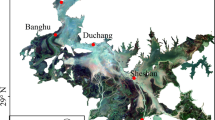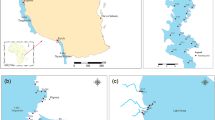Abstract
Salinization threatens the viability of water resources and is common in many important inland freshwater lakes worldwide, especially in arid and semi-arid areas. Bosten Lake is a typical inland freshwater lake that has evolved into a subsaline lake and is located in the arid region of Northwest China. The water resources of Bosten Lake are important for supplying regional drinking water and agricultural irrigation and for economic development. In this study, changes in salinity with time and space were analyzed in Bosten Lake. Overall, the salinity increased from 0.39 g/L in 1958 to 1.87 g/L in 1987, reaching its highest value in 1987. After 1987, the salinity decreased to 1.17 g/L in 2003 and increased to 1.45 g/L in 2010. Increased salinity adversely affects aquatic lake systems, regional eco-environments and water resource use, and has become a serious environmental problem in Bosten Lake. Thus, the causes of increasing salinity are discussed in this paper. Overall, the influences of climate variations and human activities resulted in the salinization of the lake. Understanding the salinization processes in Bosten Lake can be useful for implementing actions that improve water quality and water resource use in the lake.










Similar content being viewed by others
References
Aladin N, Plotnikov I (2004) The Caspian Sea. Lake basin management initiative. Casp Bull 4:112–126
Bai J, Chen X, Li J, Yang L, Fang H (2011) Changes in the area of inland lakes in arid regions of central Asia during the past 30 years. Environ Monit Assess 178:247–256
Brock T (1975) Salinity and the ecology of Dunaliella from Great Salt Lake. J Gen Microbiol 89:285–292
Chen YN, Du Q, Chen YB (2013) Study on the sustainable utilization of water resources in the Bosten Lake Basin. Science Press, Beijing (in Chinese)
Cheng QC (1995) Research on Bosten Lake. Hehai University Press, Nanjing (in Chinese)
Crosbie RS, McEwan KL, Jolly ID, Holland KL, Lamontagne S, Moe KG, Simmons CT (2009) Salinization risk in semi-arid floodplain wetlands subjected to engineered wetting and drying cycles. Hydrol Process 23:3440–3452
Dai JY, Tang XM, Gao G, Chen D, Shao KQ, Cai XL, Zhang L (2013) Effects of salinity and nutrients on sedimentary bacterial communities in oligosaline Lake Bosten, northwestern China. Aquat Microb Ecol 69:123–134
Delju A, Ceylan A, Piguet E, Rebetez M (2013) Observed climate variability and change in Urmia Lake Basin, Iran. Theor Appl Climatol 111:285–296
Dyer F, ElSawah S, Croke B, Griffiths R, Harrison E, Lucena-Moya P, Jakeman A (2014) The effects of climate change on ecologically-relevant flow regime and water quality attributes. Stoch Environ Res Risk Assess 28:67–82
Fan ZL, Alishir KP, Xu HL, Zhang QQ, Abdu M (2009) Changes of Tarim River and evolution of Lop Nor. Quat Sci 29:232–239 (in Chinese)
Guo MJ, Wu W, Zhou XD, Chen YM, Li J (2014) Investigation of the dramatic changes in lake level of the Bosten Lake in northwestern China. Theor Appl Climatol. doi:10.1007/s00704-00014-01126-y
Hammer UT (1986) Saline lake ecosystems of the world. Dr. W. Junk Publishers, Dordrecht
Hu DS, Zhang HJ (2004) Lake-evaporated salt resources and the environmental evolution in the Lop Nor region. J Glaciol Geocryol 26:212–218 (in Chinese)
Huang X, Chen F, Fan Y, Yang M (2009) Dry late-glacial and early Holocene climate in arid central Asia indicated by lithological and palynological evidence from Bosten Lake, China. Quat Int 194:19–27
James KR, Cant B, Ryan T (2003) Responses of freshwater biota to rising salinity levels and implications for saline water management: a review. Aust J Bot 51:703–713
Lawrie RA, Stretch DD (2011) Occurrence and persistence of water level/salinity states and the ecological impacts for St Lucia Estuarine Lake, South Africa. Estuar Coast Shelf Sci 95:67–76
Lerman A (2009) Saline Lakes’ response to global change. Aquat Geochem 15:1–5
Leroy S, Marret F, Gibert E, Chalié F, Reyss J-L, Arpe K (2007) River inflow and salinity changes in the Caspian Sea during the last 5500 years. Quat Sci Rev 26:3359–3383
Li JG, Philp RP, Pu F, Allen J (1996) Long-chain alkenones in Qinghai Lake sediments. Geochim Cosmochim Acta 60:235–241
Li XH, Song YD, Zahng FD, Ye M (2007) The calculation of the lowest ecological water level of Lake Bosten. J Lake Sci 19:177–181 (in Chinese)
Ling HB, Xu HL, Fu JY, Zhang QQ, Xu XW (2012) Analysis of temporal–spatial variation characteristics of extreme air temperature in Xinjiang, China. Quat Int 282:14–26
Liu ZH, Henderson AC, Huang YS (2006) Alkenone-based reconstruction of late-Holocene surface temperature and salinity changes in Lake Qinghai, China. Geophys Res Lett 33:L09707
Liu XM, Luo YZ, Zhang D, Zhang MH, Liu CM (2011) Recent changes in pan-evaporation dynamics in China. Geophys Res Lett. doi:10.1029/2011GL047929
Liu XM, Liu CM, Luo YZ, Zhang MH, Xia J (2012) Dramatic decrease in streamflow from the headwater source in the central route of China’s water diversion project: climatic variation or human influence? J Geophys Res. doi:10.1029/2011JD016879
Liu HY, Yin Y, Piao SL, Zhao FJ, Engels M, Ciais P (2013a) Disappearing lakes in semiarid northern China: drivers and environmental impact. Environ Sci Technol 47:12107–12114
Liu XM, Zhang D, Luo YZ, Liu CM (2013b) Spatial and temporal changes in aridity index in northwest China: 1960 to 2010. Theor Appl Climatol 112:307–316
Ma R et al (2010) A half-century of changes in China’s lakes: global warming or human influence? Geophys Res Lett 37:L24106
Micklin P (2007) The Aral Sea disaster. Annu Rev Earth Planet Sci 35:47–72
Mosley LM, Zammit B, Jolley AM, Barnett L (2014) Acidification of lake water due to drought. J Hydrol 511:484–493
Naftz D, Angeroth C, Freeman M, Rowland R, Carling G (2013) Monitoring change in Great Salt Lake. Eos Trans Am Geophys Union 94:289–290
Obeysekera J, Irizarry M, Park J, Barnes J, Dessalegne T (2011) Climate change and its implications for water resources management in south Florida. Stoch Environ Res Risk Assess 25:495–516
Rimmer A, Boger M, Aota Y, Kumagai M (2006) A lake as a natural integrator of linear processes: application to Lake Kinneret (Israel) and Lake Biwa (Japan). J Hydrol 319:163–175
Small I, Van der Meer J, Upshur R (2001) Acting on an environmental health disaster: the case of the Aral Sea. Environ Health Perspect 109:547
Smedema LK, Shiati K (2002) Irrigation and salinity: a perspective review of the salinity hazards of irrigation development in the arid zone. Irrig Drain Syst 16:161–174
Sullivan CA (2014) Planning for the Murray–Darling Basin: lessons from transboundary basins around the world. Stoch Environ Res Risk Assess 28:123–136
Timms BV (2005) Salt lakes in Australia: present problems and prognosis for the future. Hydrobiologia 552:1–15
Tweed S, Leblanc M, Cartwright I, Favreau G, Leduc C (2011) Arid zone groundwater recharge and salinisation processes; an example from the Lake Eyre Basin, Australia. J Hydrol 408:257–275
Wang X, Bai SY, Lu XG, Li QF, Zhang XL, Yu L (2008) Ecological risk assessment of eutrophication in Songhua Lake, China. Stoch Environ Res Risk Assess 22:477–486
Wang SX, Wu B, Guo YC (2012) The land-use change and it ecosystem services value effects in Yanqi Basin Oasis, Xinjiang. J Arid Land Resour Environ 26:138–143 (in Chinese)
Williams WD (1991) Chinese and Mongolian saline lakes: a limnological overview. Hydrobiologia 210:39–66
Williams WD (1999) Salinisation: a major threat to water resources in the arid and semi-arid regions of the world. Lakes Reserv Res Manag 4:85–91
Williams WD (2001) Anthropogenic salinisation of inland waters. Hydrobiologia 466:329–337
Wünnemann B, Mischke S, Chen F (2006) A Holocene sedimentary record from Bosten Lake, China. Palaeogeogr Palaeoclimatol Palaeoecol 234:223–238
Xia J, Zuo QT, Shao MC (2003) Theory, method and practice on water resources sustainable utilization in Lake Bosten. Chinese Science and Technology Press, Beijing (in Chinese)
Yechieli Y, Wood WW (2002) Hydrogeologic processes in saline systems: playas, sabkhas, and saline lakes. Earth Sci Rev 58:343–365
Zeinoddini M, Tofighi MA, Vafaee F (2009) Evaluation of dike-type causeway impacts on the flow and salinity regimes in Urmia Lake, Iran. J Gt Lakes Res 35:13–22
Zhao JF, Qin DH, Nagashima H, Lei JQ, Wei WS (2007) Analysis of mechanism of the salinization process and the salinity variation in Bosten Lake. Adv Water Sci 18:475 (in Chinese)
Zhou CH, Lou GP, Li C (2001) Environmental change in Bosten Lake and its relation with the oasis reclamation in Yanqi Basin. Geogr Res 20:14–23 (in Chinese)
Zuo QT, Dou M, Chen X, Zhou KF (2006) Physically-based model for studying the salinization of Bosten Lake in China. Hydrol Sci J 51:432–449
Acknowledgments
This work has been supported by National Basic Research Program of China under Grant (No. 2012CB723201).
Author information
Authors and Affiliations
Corresponding author
Rights and permissions
About this article
Cite this article
Guo, M., Zhou, X., Li, J. et al. Assessment of the salinization processes in the largest inland freshwater lake of China. Stoch Environ Res Risk Assess 29, 1823–1833 (2015). https://doi.org/10.1007/s00477-014-0995-z
Published:
Issue Date:
DOI: https://doi.org/10.1007/s00477-014-0995-z




